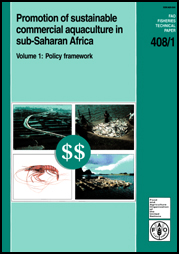
by
Neil Ridler
Visiting Scientist,Professor of Economics
The University of New Brunswick
New Brunswick,Canada
and
Nathanael Hishamunda, Ph. D.
Fishery Planning Analyst
Fishery Policy and Planning Division
FAO Fisheries Department
FAO
FISHERIES
TECHNICAL
PAPER
408/1
Food
and Agriculture
Organization
of
the
United
Nations
Rome, 2001
|
The designations employed and the presentation of the material in this information product do not imply the expression of any opinion whatsoever on the part of the Food and Agriculture Organization of the United Nations concerning the legal status of any country, territory, city or area or of its authorities, or concerning the delimitation of its frontiers or boundaries. |
ISBN 92-5-104567-4
All rights reserved. Reproduction and dissemination of material in this information product for educational or other non-commercial purposes are authorized without any prior written permission from the copyright holders provided the source is fully acknowledged. Reproduction of material in this information product for resale or other commercial purposes is prohibited without written permission of the copyright holders. Applications for such permission should be addressed to the Chief, Publishing and Multimedia Service, Information Division, FAO, Viale delle Terme di Caracalla, 00100 Rome, Italy or by e-mail to [email protected]
© FAO 2001
PART I. THE CONTEXT OF COMMERCIAL AQUACULTURE
Justification and Objective of the Study
Methodological Framework
About the ReportCHAPTER 2. CONCEPT OF SUSTAINABLE COMMERCIAL AQUACULTURE
CHAPTER 3. ADVANTAGES AND DISADVANTAGES OF COMMERCIAL AQUACULTURE
CHAPTER 4. PREREQUISITES FOR SUCCESSFUL COMMERCIAL AQUACULTURE
PART II. POLICIES TO PROMOTE SUSTAINABLE COMMERCIAL AQUACULTURE
CHAPTER 5. NON-SECTOR SPECIFIC POLICIES
Good Governance
Openness to Trade and Macroeconomic Growth Policies
Emphasis on the Private Sector as the Source of Wealth CreationCHAPTER 6. SECTOR-SPECIFIC POLICIES AT THE MACRO LEVEL
Regulatory/Legal, Administrative, Economic and Self-policing Frameworks
Supply and Demand-driven Sector-specific PoliciesCHAPTER 7. SECTOR-SPECIFIC POLICIES AT THE FARM LEVEL
Rationale for Government Intervention at the Farm Level
Start-up Policies
Expansionary Policies
Export Promotion Policies
Summary
OVERALL SUMMARY AND CONCLUSIONS
APPENDIX A - Checklist of factors by potential investors and bankers